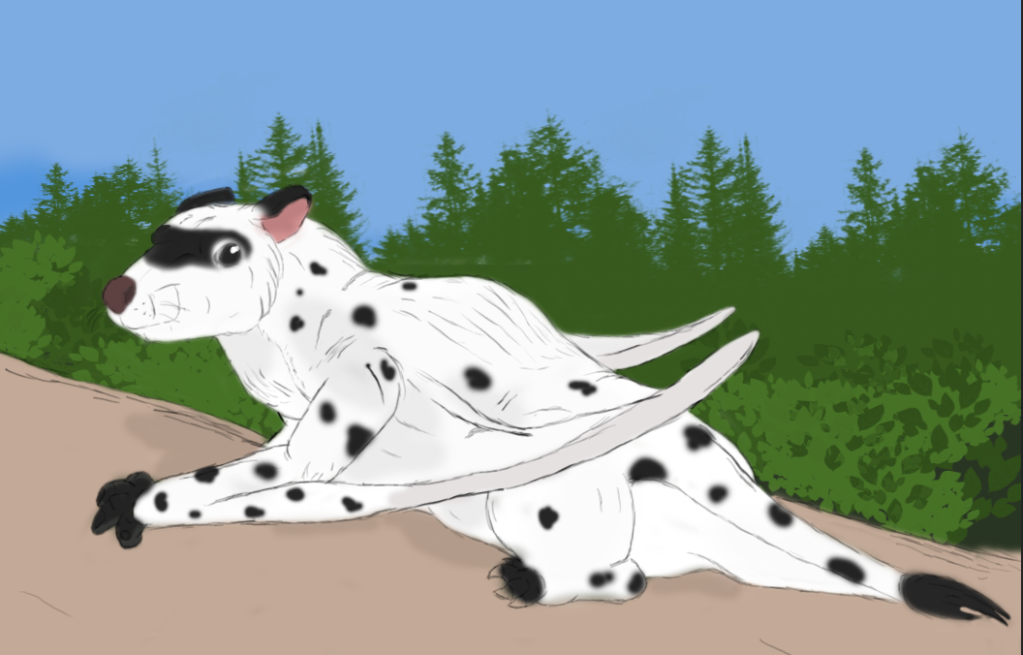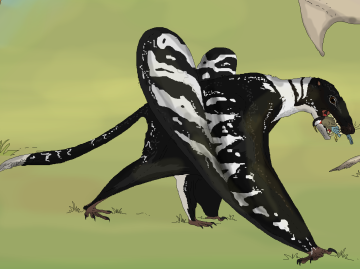
Reconstruction of the Cretaceous Indotriconodon magnus based on modern extant relatives, by omegafreelancer.
The shadow to the feathered flying lemurs, the volaticotheres of Lemuria are an ancient lineage whose origins stretch all the way back to the Jurassic, with forms like Argentoconodon and Volaticotherium pioneering mammalian flight 70 million years before other mammals took to the air. The latest Cretaceous Indotriconodon magnus is likely a close relative to the extant taxa; genetic studies show that living volaticothere lineages are no older than the Palaeocene. They occur, simultaneously, in the fossil sites of both Maldivia and Marama in the Eocene, flight likely being the reason for their success across both landmasses before they collided. Indeed, prior to the Pliocene they were the apex predators of these landmasses, some extinct forms attaining wingspans of four meters, being the largest mammals that ever flew. Only with the late Miocene climatic changes did these giants decline, giving way to the new apex predators of Lemuria proper: the giant raptors.
Still, the even today volaticotheres occupy the dominant mesocarnivore niches in Lemuria, being analogous to the weasels, mongooses, small canids and small felines of other landmasses. Except, you know, with the ability to fly. Over 45 species occur today in Lemuria, with 6 also found in Madagascar and nearby Indian Ocean islands. Three species occur outside of Lemuria: the African Kongamato (Afrodactylus kogamato), the Southeast Asian Ahool (Pitheconycteris ahool) and the Australasian Ropen (Luminopteryx ropen). The last two in particular are the earliest diverging crown volaticotheres, having diverged from their Lemuro/Malagasy cousins in the Palaeocene and from each other in the Oligocene, likely brought to their current range by the collision of India with Asia; as Indian Ocean winds blow majorly from east to west, most of the volaticothere diversity was kept from flying to Asia. It’s also speculated that the Van Meter cryptid was a volaticothere, but so far no remains have been found in the Americas.
Volaticotheres are among Lemuria’s various non-therian mammal groups, and the only non-therian mammals to fly (flight otherwise occurs in the placental bats and flying lemurs). Their wings are composed of a patagium stretched by a styliform bone, similar to that seen in flying squirrels but elongated and strengthened into resembling the pterosaurian wingfinger; the old mammalian tarsal spur in turn became a structure akin to the bat calcar, supporting the uropatagium. The membrane itself has various muscle and collagen fibers that prevent fluttering, much as with the wing membranes of bats. Of all mammalian flyers, volaticotheres are arguably the most efficient due to their epipubic bones, which support muscle groups that aid in lung ventilation; this has allowed them to produce larger flyers with more endurant flight. They are however less agile than bats and some flying lemurs, seeing as their styliform is not as flexible as their wingfingers. Like other flying mammals the ability to fly demmands an immune system with less extreme inflammatory reactions, and so their cells have similar “self-fixing” programs. This allows them to survive with high quantities of viruses without being infected, but makes them especially vulnerable to other pathogens. The Ropen has however found a symbiotic relationship with bioluminescent fungi in its wing membranes, making it the only bioluminescent terrestrial vertebrate (the same might also apply to the Van Meter cryptid, assuming it exists and is a volaticothere). Their unique metabolic and immune systems also allow for longer lifespans, with some species living almost as long as humans reaching over eighty years old.
Most volaticotheres are nocturnal, using sight and hearing as their main senses, though some species has also an accute sense of smell, particularly dedicated scavengers. Some species echolocate, but not to the extent of bats and mostly just to locate perching sites. Some species are highly social, gathering in large flocks when not foraging, but larger species are mostly solitary.
Like bats and flying lemurs they give birth to highly altricial young, some relatively developed but still dependent on their mothers for several months. Like all flying mammals they can only attain flight when close to adult size, which in some species may take over an year. Several species form creches like bats and flying lemurs, finding safety in numbers while their mothers forage. Others make nests, and in some both parents take care of the young.
The varying diversity of volaticotheres means that different species have different symbolic values to the cultures of Lemuria. Typically though they’re considered the shadow to the flying lemur’s light, and many species are considered signs of bad omens, not helped by their zoonotic diseases. Many however consider them excellent pest control, and some have attained an unique totemic status in indigenous religions, particularly the large and impressive Walamul. Indeed the Vavaitosy (Felipterus aloeri) has been semi-domesticated, allowing to patrol and nest in Sammangal gardens and trained for falconry. Many are endangered due to habitat loss and the spread of fungal diseases, but some have quite adapted to city life, and their ability to fly gives them an advantage over competing introduced species like cats, dogs and mongooses.
These beasts were the first to take to the air, and hopefully will remain fluttering about for millions of years to come.
Walamul (Walamulia giganteus)

The largest living flying mammal, the Walamul (Werer; also known as Avaitosy in Atratra, and various other regional names like Yauava in Lemurian Tamil) reaches a wingspan of three meters and up to 5 kg, though smaller estimates are more common.
It is distributed across Lemuria, though it favours the rainforest regions, where there are fewer large raptors to compete with. Accordingly, its white and black color suits it well when it hunts in low light conditions (it is primarily nocturnal) and its rounded wings suit it well as it flies in the dense forest. It is a fearsome predator, echoing the ancient giant volaticotheres as it pounces on mid-sized gondwanatherians or even elephant calves, but thanks to its ability to fly it can rely on a mostly scavenging diet. It has a better sense of smell than most of its relatives, and its larger size allows it to displace smaller predators and scavengers, aside from the birds of prey.
It is a largely solitary animal, but it can tolerate the presence of two or three members of its species in its territory. Most such small groupings tend to be siblings, or parents and children. Breeding happens every four years, males following females by urine scent and spending a long period of time trying to court them, producing low pitched sounds. After mating the female raises the sole pup alone, usually left in a crevice or tree hollow while she hunts. The juvenile spends over an year being raised this way, and even after acquiring its independence it may stay within their mother’s territory for years.
The Walamul is symbolic of the night itself across Lemuria’s cultures, and simultaneously revered and feared; while this animal rarely poses a threat to people, it may target livestock, though traditionally this is deterred by leaving piles of scrap and unusable carcasses in order to dstract it non-lethally. It most famously appears in The Drama of the Moon, where it is the final challenge for the two competing gods. In western Lemuria, where it is less common, it is seen particularly ambivalently as an enemy of the Sun Goddess, yet also a bringer of rain. In many areas it is a totemic symbol of great importance, and some people claim descent from the Walamul as an ancestor spirit.
Currently, it is Vulnerable due to habitat loss and occasional persecution as non-traditional agriculture declines and prejudices increase. Conservation efforts have been successful in raising its population from a bottleneck in the 60’s, and the animal can even occasionally be seen in urban areas. Cats and small dogs are occasionally targetted, but such urbanite volaticotheres often preffer to attack trash cans.
2 responses to “Volaticotheres of Lemuria”
[…] A personification of both the Walamul, the largest flying mammal, as well as of the night […]
LikeLike
[…] Naturally, I also used this image to forward my speculative volaticotheres over at Lemuria. […]
LikeLike